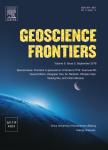The dilemma of the Jiaodong gold deposits: Are they unique?
The dilemma of the Jiaodong gold deposits: Are they unique?作者机构:U.S.Geological Survey Box 25046 MS 973 Denver Federal Center State Key Laboratory of Geological Processes and Mineral Resources School of Earth Sciences and Resources China University of Geosciences Centre for Exploration Targeting School of Earth and Geographical Sciences University of Western Australia Crawley
出 版 物:《Geoscience Frontiers》 (地学前缘(英文版))
年 卷 期:2014年第5卷第2期
页 面:139-153页
核心收录:
学科分类:070704[理学-海洋地质] 081803[工学-地质工程] 0709[理学-地质学] 07[理学] 08[工学] 0707[理学-海洋科学] 0818[工学-地质资源与地质工程]
主 题:Gold Jiaodong North China block Tectonics Mineral deposit mode
摘 要:The ca. 126e120 Ma Au deposits of the Jiaodong Peninsula, eastern China, define the country's largest gold province with an overall endowment estimated as>3000 t Au. The vein and disseminated ores are hosted by NE-to NNE-trending brittle normal faults that parallel the margins of ca. 165e150 Ma, deeply emplaced, lower crustal melt granites. The deposits are sited along the faults for many tens of kilometers and the larger orebodies are associated with dilatational jogs. Country rocks to the granites are Pre-cambrian high-grade metamorphic rocks located on both sides of a Triassic suture between the North and South China blocks. During early Mesozoic convergent deformation, the ore-hosting structures developed as ductile thrust faults that were subsequently reactivated during Early Cretaceous "Yan-shanian"intracontinental extensional deformation and associated gold formation. 〈br〉 Classification of the gold deposits remains problematic. Many features resemble those typical of orogenic Au including the linear structural distribution of the deposits, mineralization style, ore and alteration assemblages, and ore fluid chemistry. However, Phanerozoic orogenic Au deposits are formed by prograde metamorphism of accreted oceanic rocks in Cordilleran-style orogens. The Jiaodong de-posits, in contrast, formed within two Precambrian blocks approximately 2 billion years after devolati-lization of the country rocks, and thus require a model that involves alternative fluid and metal sources for the ores. A widespread suite of ca. 130e123 Ma granodiorites overlaps temporally with the ores, but shows a poor spatial association with the deposits. Furthermore, the deposit distribution and mineral-ization style is atypical of ores formed from nearby magmas. The ore concentration requires fluid focusing during some type of sub-crustal thermal event, which could be broadly related to a combination of coeval lithospheric thinning, asthenospheric upwelling, paleo-Pacific plate subducti



